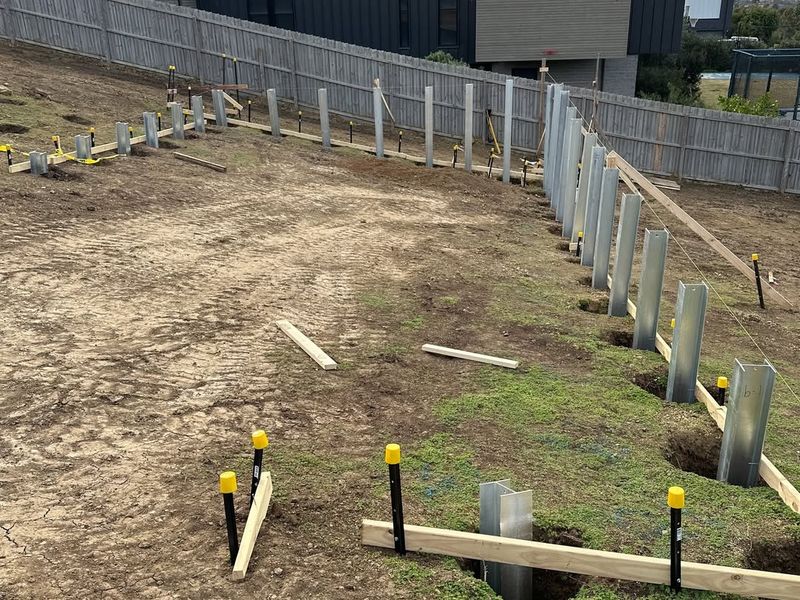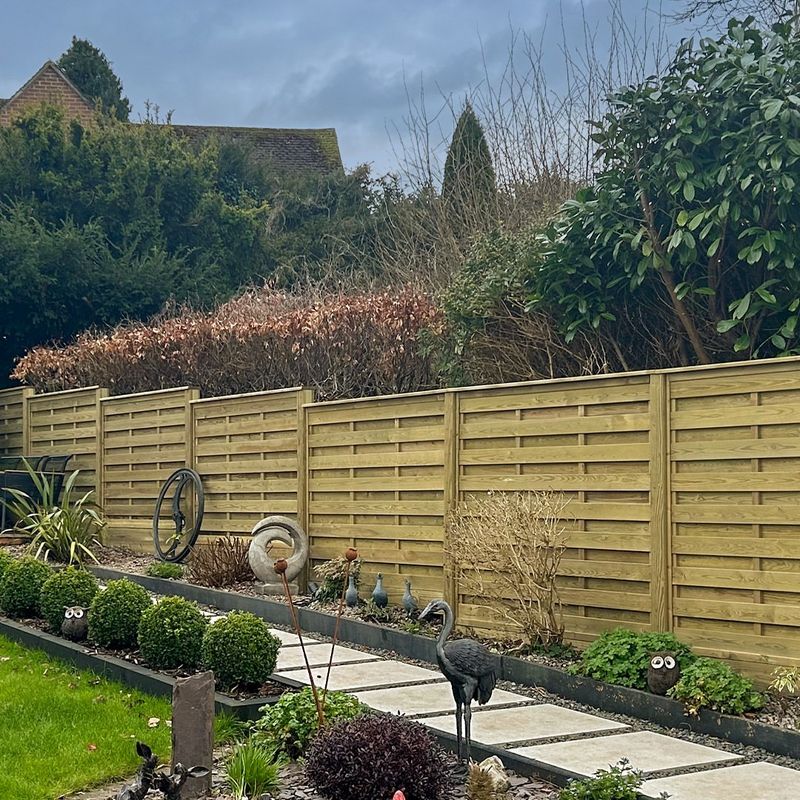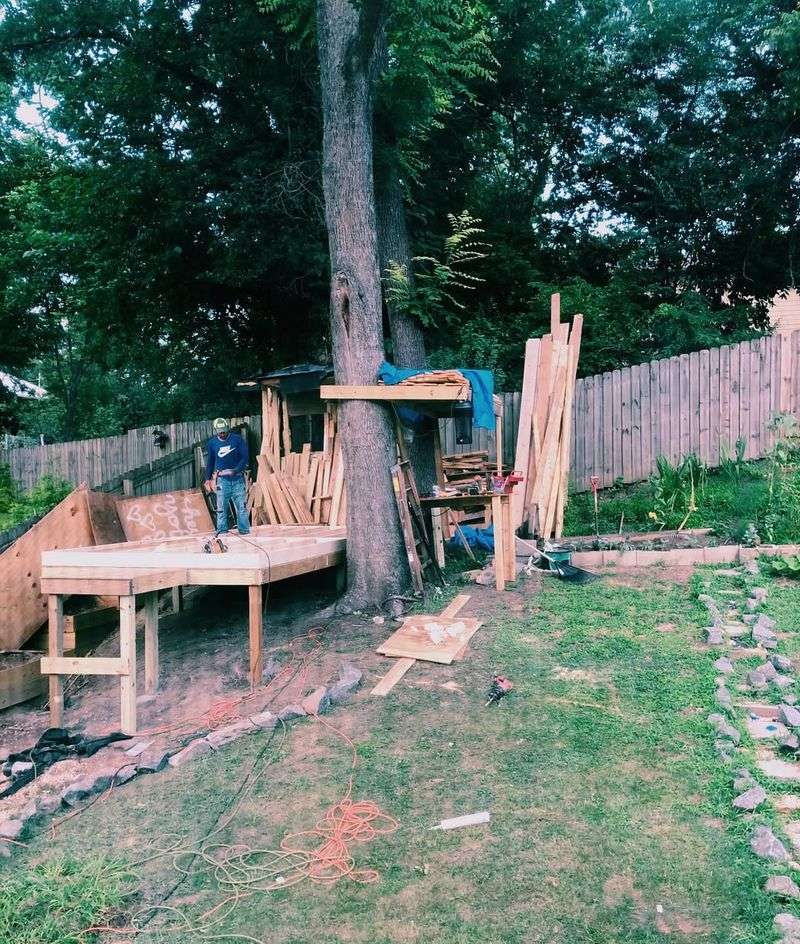Strong gusts roll across open yards, and many fences show the scars.
Boards loosen, posts wobble, and long seams shift just enough to signal trouble ahead.
I walk past damaged panels and spot weak points that once stood firm, now tired from constant pressure.
Homeowners often feel blindsided, since a single blustery night can push a fence past its limit.
Local specialists note the same pattern each year: fast repairs prevent a full collapse, while hesitation invites bigger problems.
A practical solution stands within reach, and anyone who deals with sudden wind damage can regain control with one simple adjustment.
Reinforce Posts With Concrete Footings
Fence posts that wobble or lean are accidents waiting to happen when strong winds arrive.
The foundation of any sturdy fence starts underground, where concrete footings create an anchor that holds everything in place during storms.
Kansas experts recommend digging post holes at least three feet deep and filling them with fast-setting concrete mix.
This depth gets below the frost line and prevents posts from shifting when the ground freezes and thaws.
The concrete should extend slightly above ground level to keep water from pooling around the base.
For existing fences showing signs of weakness, you can add concrete around loose posts without replacing the entire structure.
Simply dig around the post, clean out old dirt, and pour fresh concrete to stabilize it.
Corner posts and gate posts need extra attention because they handle more stress than regular fence posts.
Many professionals suggest using larger diameter posts at these critical points.
Metal post anchors embedded in concrete provide additional strength against twisting forces.
Taking time to properly secure your fence posts creates a solid foundation that withstands December’s worst weather.
This single improvement can mean the difference between a fence that survives the season and one that ends up scattered across your yard.
Install Wind-Resistant Fence Panels
Solid fence panels act like giant sails when December winds hit, catching air and creating tremendous pressure that can rip sections right off their posts.
Wind-resistant designs solve this problem by allowing air to flow through instead of pushing against a solid wall.
Horizontal board fencing with small gaps between each plank reduces wind load by up to forty percent compared to solid panels.
The spaces let gusts pass through while still providing privacy and security.
Shadow box fencing offers another smart option, with alternating boards on each side creating an attractive pattern that also manages wind pressure.
Chain link and ornamental metal fences naturally handle wind better than wood because of their open design.
If you prefer wood but need better wind protection, consider installing lattice panels or decorative cutouts in solid sections.
Vinyl fencing manufacturers now make panels specifically engineered for high-wind areas, with reinforced frames and strategic perforations.
These modern materials resist cracking in cold temperatures while standing up to harsh weather conditions.
When replacing damaged sections after a storm, choosing wind-resistant panels prevents future problems.
The initial investment pays off by reducing repair costs and extending your fence’s lifespan through many Kansas winters.
Add Cross Bracing For Extra Support
Picture a fence swaying back and forth during a windstorm, and you’ll understand why cross bracing matters so much.
Diagonal supports connect posts to rails, creating triangular shapes that distribute force and prevent racking movement.
Professional fence builders in Kansas use cross bracing on tall fences over six feet high, where wind pressure increases dramatically.
The diagonal boards or metal straps run from the top of one post to the bottom rail of the next section, forming an X pattern that adds incredible strength.
You can add bracing to existing fences by attaching treated lumber or metal brackets between posts and rails.
Galvanized steel cables offer another option, tensioned tight to create rigid support without blocking views through the fence.
Gates especially benefit from cross bracing because they lack the continuous support of regular fence sections.
A simple diagonal brace from the top hinge corner to the bottom latch corner prevents sagging and keeps gates functioning smoothly through winter weather.
Hardware stores sell pre-made bracing kits that include all necessary brackets and fasteners.
Installation takes just a few hours but dramatically improves how your fence handles stress from wind, snow, and temperature changes throughout December and beyond.
Maintain Proper Fence Height Standards
Taller fences might seem like better barriers, but they actually create bigger targets for Kansas December winds to attack.
Every foot of additional height increases wind load exponentially, making shorter fences much more stable during storms.
Building codes in most Kansas communities limit residential fence height to six feet for good reasons related to safety and wind resistance.
Fences exceeding this height catch more wind and require significantly stronger construction to avoid damage.
If you need privacy or security beyond what a six-foot fence provides, consider combining a standard-height fence with landscaping.
Evergreen shrubs or ornamental grasses planted along the fence line add screening without creating a solid wind barrier.
Stepped fencing works well on sloped properties, maintaining consistent height above ground level while following the terrain.
This approach keeps each section within safe height limits while adapting to your yard’s natural contours.
Before building or replacing fencing, check local regulations about height restrictions and setback requirements.
Some neighborhoods have homeowner association rules that further limit fence dimensions.
Existing tall fences showing wind damage might need sections lowered or reinforced with additional posts spaced closer together to meet current standards and survive future storms.
Upgrade To Heavy-Duty Fasteners And Hardware
Cheap screws and flimsy brackets are no match for the powerful forces generated when December winds slam into your fence.
Hardware failure causes more fence damage than rotted wood, with panels separating from posts when fasteners pull loose or snap under pressure.
Stainless steel or hot-dipped galvanized screws resist rust and maintain holding power through years of weather exposure.
These premium fasteners cost more than basic hardware but prevent the gradual loosening that weakens fence connections over time.
Structural screws designed specifically for outdoor construction penetrate deeper and grip tighter than standard wood screws.
Their specialized threads and thicker shanks handle the shear forces created when wind pushes against fence panels.
Metal brackets connecting rails to posts should be through-bolted rather than just screwed on.
Carriage bolts with washers and nuts create connections that won’t pull out even during extreme weather events.
Replacing old, rusted hardware before winter arrives prevents failures during the worst possible time.
Walk your fence line and check every connection point, tightening loose fasteners and replacing any showing corrosion or damage.
This simple maintenance task takes just an afternoon but significantly improves your fence’s ability to withstand Kansas winter winds.
Create Strategic Windbreaks With Landscaping
Nature provides one of the best defenses against wind damage through properly placed trees and shrubs that slow air movement before it reaches your fence.
Landscaping windbreaks reduce wind speed by up to fifty percent, dramatically lowering the force hitting fence panels.
Evergreen trees like eastern red cedar and Austrian pine stay full year-round, providing winter protection when deciduous trees lose their leaves.
Planting these trees fifteen to twenty feet away from your fence creates an effective buffer zone without root systems that might damage fence footings.
Shrub rows planted closer to the fence add another layer of wind protection while enhancing your yard’s appearance.
Juniper, yew, and boxwood varieties tolerate Kansas weather and grow dense enough to deflect wind upward over the fence.
Staggered plantings work better than straight lines because they eliminate gaps where wind can funnel through at increased speed.
Mix different plant heights and types to create a natural-looking barrier that handles wind from multiple directions.
Young plants need several growing seasons to reach protective size, so start your windbreak project before damage occurs.
Combining living windbreaks with properly built fencing creates a comprehensive defense system that protects your property investment for decades while adding beauty and wildlife habitat to your landscape.
Schedule Regular Seasonal Inspections
Waiting until fence panels are scattered across your yard means you’ve waited too late to address problems.
Regular inspections catch small issues before December winds turn them into expensive disasters.
Walk your entire fence line each fall, looking for loose boards, leaning posts, and rusted hardware that needs attention.
Push against posts to check for movement, and wiggle rails to find weak connections.
Early detection allows repairs during comfortable weather instead of emergency fixes in freezing temperatures.
Pay special attention to areas where previous damage occurred, as these spots often develop recurring problems.
Gates and corners handle more stress than straight runs, so inspect these sections extra carefully.
Take photos during inspections to document your fence’s condition and track changes over time.
These records help identify patterns and plan maintenance schedules effectively.
Professional fence companies offer inspection services if you’re unsure what to look for or prefer expert assessment.
Their trained eyes spot potential failures you might miss, and they can provide repair estimates before winter arrives.
Catching problems early saves money and prevents total fence failure during storms.
A small repair in November costs far less than replacing entire sections after December winds have done their worst damage to neglected fencing.
Apply Protective Sealant Before Winter
Wood fences face a double threat during Kansas winters as moisture and temperature swings cause expansion, contraction, and eventual structural weakness.
Protective sealants create waterproof barriers that keep wood strong and flexible through months of harsh conditions.
Water-repellent sealers penetrate wood fibers and prevent moisture absorption that leads to cracking, splitting, and rot.
Applying sealant every two to three years maintains protection and extends fence life significantly compared to untreated wood.
Fall application timing matters because sealants need dry conditions and moderate temperatures to properly cure.
Late September through October offers ideal weather windows before winter storms arrive.
Clean the fence thoroughly before sealing, removing dirt, mildew, and loose paint that prevent proper adhesion.
Semi-transparent stains combine color with protection, letting wood grain show through while blocking UV rays and moisture.
Solid stains offer maximum protection for older fences showing wear, essentially painting a protective coating over weathered surfaces.
Spray applicators speed the sealing process on long fence runs, while brushes work better for detailed work around posts and hardware.
Two thin coats provide better protection than one heavy application that might drip or puddle.
Sealed wood maintains strength and flexibility that helps fences survive wind stress without breaking.
This simple preventive treatment costs pennies per square foot but prevents damage that would require costly repairs or complete replacement.









